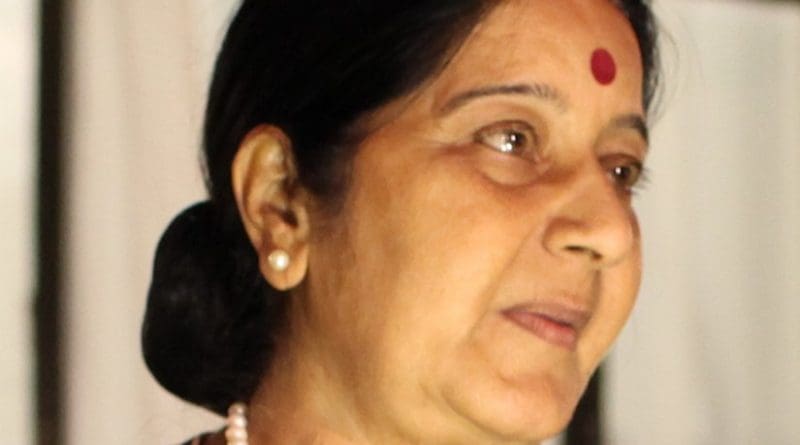India’s Sushma Swaraj In Nepal: Reinvigorating Bilateral Relations? – Analysis
By IPCS
By Pramod Jaiswal*
On 2 February 2018, India’s Minister of External Affairs, Sushma Swaraj, made a surprise visit to Nepal at a time when the Left Alliance in Nepal is set to form a new government under KP Sharma Oli’s leadership. What does the visit mean? How will it impact Nepal’s politics?
An Agenda-less Visit?
Soon after landing in Kathmandu, Swaraj said that she did not have any specific agenda for the visit and that the visit was to meet friends from all political parties and strengthen friendship. During her 24-hour long visit, she had one-to-one meetings with the Chairman of the Communist Party of Nepal (Unified Marxist Leninist) [CPN-UML], KP Sharma Oli; Chairman of the Communist Party of Nepal (Maoist Center) [CPN-MC], Pushpa Kamal Dahal ‘Prachanda’; and the Chairman of the Federal Socialist Forum, Nepal [FSFN], Upendra Yadav. She also attended a dinner hosted by KP Sharma Oli and lunch by Prime Minister Sher Bahadur Deuba. Additionally, she also called on Nepal’s President Bidhya Devi Bhandari and met with the leaders of Rastriya Janta Party, Nepal (RJPN).
There are reasons Swaraj chose to hold talks with CPN-UML Chairman KP Sharma Oli first. Oli is the unchallenged leader of Nepal’s Left alliance and is likely to be the next prime minister. The relationship between India and Oli soured in 2015 when India voiced concerns over Nepal’s then-newly promulgated constitution, which encouraged Madhesis to create obstruction at the India-Nepal border resulting in an acute shortage of fuel and other essential goods in Kathmandu. Oli signed a trade and transit agreement with China with the objective of ending India’s monopoly over Nepal’s supply of daily essentials. India saw Oli as an adversary, playing the “China card” and creating anti-Indian sentiments in Nepal, who needed to be kept out. This encouraged the Nepali Congress and CPN-MC coalition, as a result of which the Oli government collapsed and CPN-MC Chairman Prachanda and Nepali Congress Chairman Sher Bahadur Deuba served as the prime minister for the remaining term.
However, India faced setback when CPN-UML and CPN-MC — two of the largest communist parties in Nepal — announced that they would contest provincial and federal parliament elections in alliance and would step towards forming a single Left party in the country. Unsurprisingly, the Left Alliance claimed a thumping victory, assuring a second term for Oli. India was thus left with limited options. New Delhi realised that ignoring the largest party could give a free hand to China in Nepal and that engaging with Oli and the Left Alliance is necessary to secure its interests in Nepal. China has already taken advantage of India-Nepal tensions since September 2015. As a result, India’s Prime Minister Narendra Modi telephoned Oli twice. In the second conversation, Modi expressed his eagerness to work with Oli’s government and invited him to come to India after taking over as prime minister; and Oli invited Modi to visit religious sites of Nepal such as Muktinath, Janakpur and Lumbini.
In a letter sent on India’s Republic Day, Oli assured Modi that he is keen to work with his Indian counterpart on bilateral issues. Thus, the main objective of Swaraj’s visit was to mending relations with Oli, who may take over as prime minister in March 2018. She wanted to reassure Oli that India wants to be friends with him, desires to work together with his government, and extend India’s invitation to him. This was the primary the reason why Swaraj held a one-to-one meeting with Oli for more than an hour.
Responses to the Visit in Nepal
There were mixed reactions about the visit in Nepal. While the CPN-UML look excited about playing the “China card” and causing India to take a reconciliatory approach, the Nepali Congress and the RJPN felt isolated. Nepali Congress leader Shekhar Koirala remarked that Swaraj’s visit to Nepal was untimely. He said Swaraj should have come a little later to meet the next prime minister as there is no point for her to meet the incumbent government. He even claimed that Swaraj visited Nepal after Oli requested India to send a ‘special envoy’. The RJPN felt betrayed as Swaraj skirted discussion on the matter when they raised the questions regarding constitutional amendment. Similarly, the Maoists were unhappy because they felt India’s reconciliatory approach to engage with the Oli-led government has emboldened Oli to take a rigid stance over the power sharing arrangement with the Maoists during the negotiations on government formation.
Looking Ahead
By sending its external affairs minister to Nepal, New Delhi has sent a symbolic message to Beijing that India enjoys cordial relations with Nepal despite the victory of the Left Alliance. China was upbeat after the favourable results of Left Alliance in the provincial and federal elections, believing that the results would be helpful to advance its influence in Nepal. While the visit has been successful in bringing a thaw in the India-Nepal tensions to some extent, New Delhi must be cautious about hurting the sentiments of a small state in the future by not interfering in the internal matters of Nepal. It is time for India to focus more on economic cooperation by forging equal partnership with Nepal for mutual benefits.
*Pramod Jaiswal
Visiting Research Fellow, IReS, IPCS

